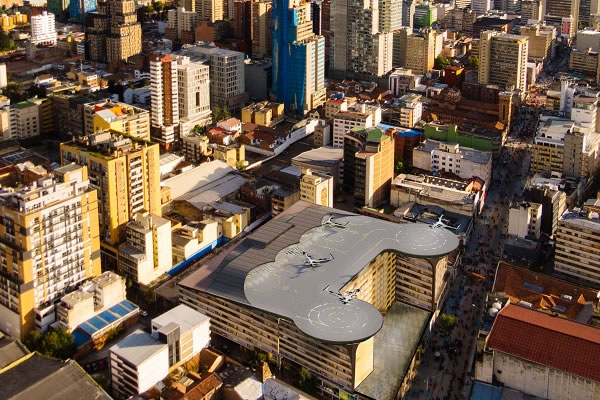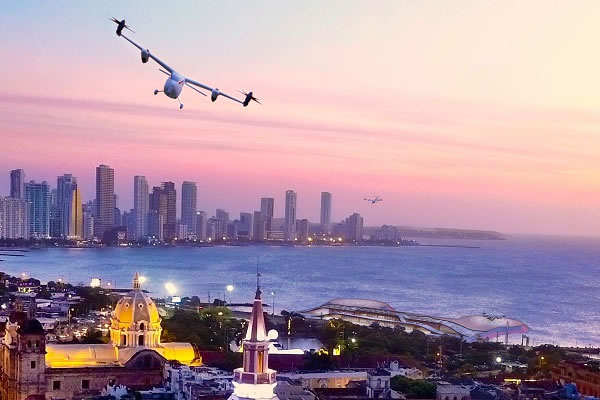Our site is undergoing a complete overhaul, we apologize for the temporary inconvenience. Our new site is expected to air on June, 2023.
Our Advanced Air Mobility Concept
Cities and regions around the world, especially in developing countries, suffer from a systematic lack of proper mobility infrastructure. They are disorderly growing in on themselves with layers upon layers of massively costly and sluggish networks while disconnection is still pervasive. This results in stressful traffic gridlocks, polluted air and socio-economic growth difficulties, severely hurting people’s quality of life.
We’ve created a new form of Mobility Infrastructure that disrupts the status quo, a new way for cities to expand and generate connection without the need to build anything in between.
VARON systems can be implemented in any region, suburb and eventually inside cities, providing fast, silent and clean connectivity in an economically fasible way, without the need to build anything in between. These connections generate new opportunities for socio-economic development for newly connected sectors and regions. It's the legacy of aviation brought down to our cities, suburbs and regions; Urban Air Mobility (UAM) seen as mobility infrastructure.
Our Vertiports
Our Vertiports are the places where our Aircraft will take-off and land, where we will service end users and where our Infrastructure Networks integrate with the surrounding city, suburb or region for complete connectivity. Varon Vehicles is designing its Vertiports with world leading architectural and designing partners, with consideration of cost-effective construction, fast implementation and reliable operation.
Vertiports can be of multiple types dpending on the markets it is serving and the types of end users involved, for instance passenger Vertiports, logistics Vertiports and medical Vertiports.

Transportation
Company Aircraft will continuously service between our Vertiports to provide transportation services to customers in diverse markets in need of connection.
Energy
Energy assets at our Vertiports required for our operation allow us to create new buinesses like energy arbitrage, sale to the grid and storage for backup.
Real Estate
The company is involved in exploiting the value generated at and around our Vertiports in commercial & office spaces and real estate developments.
Data
Large amounts of currently non existing city and environmental data will be captured persistently from on board our Air Vehicles and Vertiports, processed and sold to different data markets.









Our eVTOL Aircraft Fleets
Varon Vehicles is partnering with world renowned Aircraft manufacturing companies which are providers of its fleets. Aircraft will be chosen according to the business cases being placed into service, the location of the service configuration requirements. Currently there is joint collaboration with these OEM's to develop the parameters and operational concepts of the Air Vehicles required by Varon Vehicles.
The Aircraft OEM's collaborating with Varon Vehicles are established in the global aeronautics industry, capable of delivering certified aircraft for safe and reliable operation, some with legacies that date back many decades. Varon Vehicles will have proper maintenance, repair & overhaul (MRO) of its fleets just like any traditional airline.
This new generation of aviation is relying on enabling technologies in aeronautics that are becoming available in the current years, leveraging on high levels of automation and electric & hybrid electric vertical take-off and landing (VTOL) technologies. These are radically new aircraft capable of urban use due to their tremendous reduced costs, capabilities to navigate at very low altitudes and relatively slow speeds, vertical take-off and landing nature, greatly reduced noise and clean environmental footprint. It is an entirely new breed in aviation that falls under NASA's Advanced Air Mobility (AAM) concept for future aviation and Urban Air Mobility.
Our onboard Aircraft operators will have reduced tasks, leveraging on simplified vehicle operations (SVO) and will be trained specifically for these new types of Aircraft.
Our Airspace Architecture
Our Airspace Integration Architecture are the virtual spaces in the low altitude skies through which our aircraft will fly. Developments of our Airspace Integration Architecture are being made in conjunction with the Colombian Civil Aviation Authority. It involves the separation and traffic orchestration mechanisms, in an arrangement of virtual lanes within permanently reserved airspace volumes linking our Vertiports, to ensure maximum throughput while guaranteeing safety. Drafts have already been drawn over most major cities in Colombia with candidate Vertiport locations according to mobility demand studies.


Unique
Airspace Integration Architecture
Designed by Varon Vehicles in conjunction with Civil Aviation Authorities, from the urban perspective.
Low Altitude
Plotted within uncontrolled airspace, not sharing airspace with existing aircraft. Comfortable altitudes for regular people.
Permanently Reserved
Airspace volumes exclusively assigned to UAM air vehicles for city / suburb population mobility.
No ATC
No burden for air traffic control while UAM air vehicles stay within assigned airspace volumes.
Traffic Management System
Internal Traffic Management System (TMS) for air vehicles traffic orchestration.
Follows Urban Geodesics
Shortest path between vertiports taking into account no fly zones, existing air routes, critical infrastructure, city obstacles, known wind conditions and topography.
Safe for eVTOLs
Unlike traditional aircraft, electric take-off and landing air vehicles are safer at lower altitudes.
Pre-Established Routes
Very confined system with well defined routes through which air vehicles will service between vertiports.
No Flight Plans
UAM air vehicles pre-authorized to continuously fly through specific virtual lanes between vertiports.
Operators On Board
No Pilot-less flights, trained and certified operator on board each air vehicle.
Urban Geodesics
Defined by Varon Vehicles: The shortest path between vertiports through low altitude airspace, taking into account no fly zones, existing air routes, critical infrastructure, city obstacles, known wind conditions and topography.
Urban Geodesics are used to lay out the airspace volumes linking our vertiports, which separate our Urban Air Mobility air vehicles from all other aircraft and drones. Virtual lanes are defined within these airspace volumes for the organized flow of our air vehicles.
Urban Geodesics are a design concept that allows for safe and efficient integration of our systems into airspace over cities and suburbs. They set the framework for the establishment of predetermined and fixed air routes and the identification of safe landing locations in case of emergencies. While our air vehicles maintain themselves within these airspace volumes, they do not need to communicate with Air Traffic Control, generating no burden on existing aeronautical systems and allowing massification of Urban Air Mobility.
Public Acceptance
Acceptance by society is vital to be achieved and maintained
as we strive to propose the use of communal airspace. We feed
from lessons learned from previous intents and have defined
specific design criteria aimed at generating general public,
specific communities, governments and regulators acceptance.
Solve Problems
Society requires urban problems to be solved. We are focusing on providing a solution for the city growth problem. As we tackle this, we provide solutions for the mobility infrastructure problem, the energy infrstructure problem, the real estate infrastructure problem and the data infrastructure problem.
Serve Everyone
Our Infrastructure Networks are designed to ultimately serve everyone, not just a few elite. Our philosophy is to reach the masses in as much as possible, by being very creative in the ways in which our company can leverage on multiple revenue streams to reach low price points for broad inclusivity.
Generate Employment
Our simplistic and out-of-the-box aeronautical approach will result in the potential for broad employment opportunities for labor forces available in the communities and the tremendous "wow factor" from UAM systems will drive generations to desire involvement in a multiplicity of new areas, from operation and maintenance of our eVTOL Air Vehicles and Vertiports all the way to new administrative and staffing opportunities.
Build Safety
As number one priority, safety is the first subject in our agenda. Safety is constructed together with systems providers and local regulators by walking through the learning curve towards full certification by authorities in a gradual way and relying on systems with a legacy in aeronautics safety.
Design for Safety Perception
We strive to understand the behavioural patterns and acceptability thresholds of society where we are proposing them to adopt our novel transportation system, both as users and non-users. Aiming the design of our Airspace Integration Architecture, Air Vehicles and Vertiports at making people feel safe and comfortable, is of utmost importance.
Work With Regulators
Our Infrastructure Networks will require the creation of new regulations in order to reach placement into service. We are working with governments and Civil Aviation Authorities in Latin America as true world leaders in the generation of said regulation frameworks for harmonious paths towards implementation of our systems.
We recognize the urban mobility pain point and how it deteriorates people's quality of life, especially in developing countries. Our Infrastructure Networks are targeted to service communities and regular people. They are a disruptive mobility infrastructure solution to alleviate the existing pressure for urban growth.
Potential for Urban Sprawl
Most Latin American cities, including principal ones, are highly condensed and of reduced urban structure size, with a high pressure for city growth, held back by governments' systematic incapability to provide costly physical infrastructure.
Mobility Problem
Complex mobility problems in the Latin American region encompass endemic factors like sysematic lack of proper infrastructure, defectuous infrastructure, public health problems deriving from very high vehicle emmissions and mobility related criminality, which makes it a priority for governments and regulators to seek innovative solutions for mobility and urban growth in many countries.
Lower Costs
Lower costs for implementation, construction, certification, operation and placement into service.
New Regulations
Civil Aviation Authorities willing to lead in the writing of newly required regulations for eVTOLs and Urban Air Mobility for urban use and also open to implement new airspace integration architectures.
Weather Availability
Unlike other regions of the world, weather availability is close to 100% year round for Urban Air Mobility, allowing for continuous flight operations and faster accumulation of flight hours.
Implementing in
Latin America First
Varon Vehicles is leading its ecosystem of global partners and collaborators towards implementation in Latin America, starting in Colombia. Cooperation is underway with the Colombian Government, the Colombian Civil Aviation Authority and other local and global stakeholdersers for the implementation of a first Infrastructure Network in a chosen Colombian city.
The Latin American region offers a series of advantages to undertake the learning curve of the nascent UAM industry simpler, faster and at less cost, which has shown to be of much interest to global UAM stakeholders which have joined our ecosystem for close collaboration.
Latin American countries offer a tremendous opportunity for the implementation of radically new Mobility Infrastructure that does not require physical construction per mile to generate connectivity.



